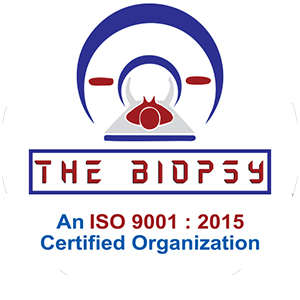

Multiple detector computed tomography or (MDCT) scanning is a rapid, painless diagnostic procedure that combines the use of computers and x-rays. A MDCT scan allows the radiologist to see the location, or abnormalities.
Multiple images are acquired in a sequence by a rotating x-ray tube. All you need to do is lie still on a table for approximately 5 to 15 minutes, depending on the area of concern being covered. The table top will move you through a gantry (shaped like a big donut) which houses the x-ray tube and a multiple set of detectors. Images are acquired by the detectors that pick up the x-ray that passes through your body. The images are then sent to the computer which reconstructs the images onto the screen for the technologist to view. The technologist will then review the quality of the images, once satisfied with the content of the exam you will be free to leave. The technologist will then process this information to create an examination that the radiologist can then review and interpret.
Some MDCT studies require an oral contrast agent to enhance the images that are taken of your body. You will recceive special instructions if your exam requires you to consume an oral contrast agent ((Redicat) in advance. Other studies may use an I.V. contrast agent (Isovue or Visipaque) to enhance the images.
What is Computerized Tomography (CT)?
CT is a noninvasive test that uses X-rays to make pictures of your heart. Modern CT scanners (multidetector CT, or MDCT) work very fast and detailed. They can take images of the beating heart, and show calcium and blockages in your heart arteries.
Quick facts
Doctors may ask you to have MDCT when other tests, such as chest X-rays, electrocardiograms (ECG), echocardiograms (echocardiography), or stress tests, don’t give them enough information about your heart.
Through MDCT, your doctors may gather additional information on:
Can MDCT help show if you have heart disease?
When contrast dye (iodine) is given during the scan, MDCT can be used to show blockages in your heart arteries. This is useful in patients with chest discomfort to see if the discomfort comes from lack of blood flow to the heart muscle caused by blocked heart arteries (angina). If the heart arteries are normal, your doctor can confidently look into other causes of chest pain that aren’t related to the heart.
With contrast dye, MDCT can also be used to check if coronary artery bypass grafts remain open, check for congenital heart defects (problems present at birth) and also check how your ventricles are working.
Without contrast dye, MDCT can be used to measure the amount calcium in your heart arteries (“calcium score”). Your calcium score gives doctors an idea of how much plaque there is in your heart arteries that hasn’t caused problems yet. Your calcium score may help predict your risk of a heart attack, and tell you and your doctor how much more aggressive you should be to reduce your risk factors. This is particularly helpful if you are at “intermediate” risk.
Calcium scoring is not recommended for routine screening of people who don’t have symptoms of heart disease and have a low risk of heart attacks. If you’ve already had a heart attack, coronary bypass surgery or a coronary stent, calcium scoring won’t provide any additional information.
Can I have MDCT instead of a coronary angiogram?
MDCT is not a substitute for a coronary angiogram (cardiac catheterization). Coronary angiography is the most accurate method for showing blockages in the coronary arteries. It also gives very specific information about how your heart is working.
What are the risks of MDCT?
MDCT exposes you to a low dose of X-rays. Experts disagree if X-rays at such low doses can cause cancer, but the possibility exists that no dose of X-rays, however low, is completely safe. Don’t take the test if you’re pregnant. Don’t take the test if your risk for a heart attack is low, or if there is no other reason (chest discomfort) to think that you have heart trouble.
Some people have allergic reactions to the contrast dye that’s sometimes used in the test. Before the test, tell your doctor if you’re allergic to dyes, iodine or shellfish.
How do I prepare for MDCT?
Ask your doctor if he or she plans to give you contrast dye during the test. If so, don’t eat for four to six hours before the test. If contrast dye won’t be used, don’t eat for two hours before the test.
What happens during EBCT?
Technicians perform MDCT in hospitals or special outpatient clinics.
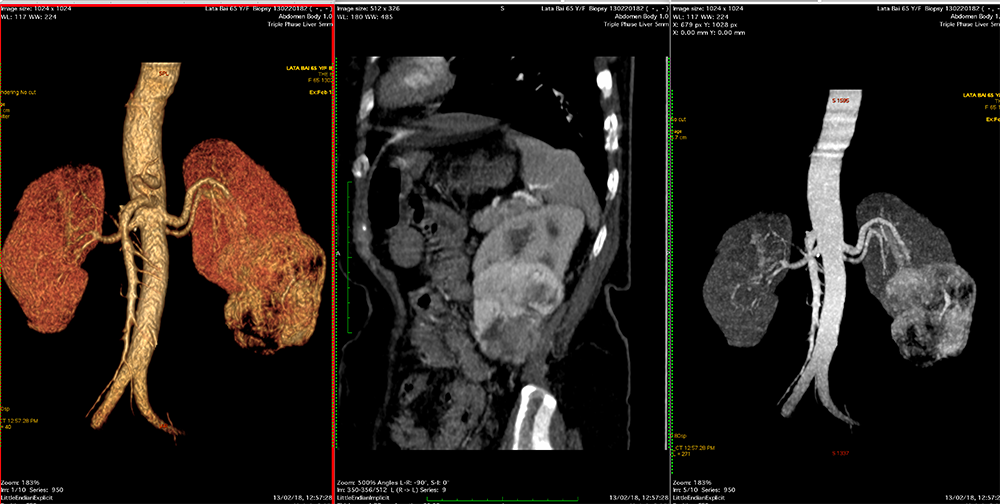
Computed tomography (CT) enterography uses special x-ray equipment and an injection of contrast material after the ingestion of liquid to produce detailed images of the small intestine and structures within the abdomen and pelvis. It’s often used to identify and locate problems within the bowel, such as inflammation, bleeding, obstructions and Crohn’s disease. CT scanning is fast, painless, noninvasive and accurate. CT enterography is better able to visualize the entire thickness of the bowel wall when compared to other small intestine imaging procedures.
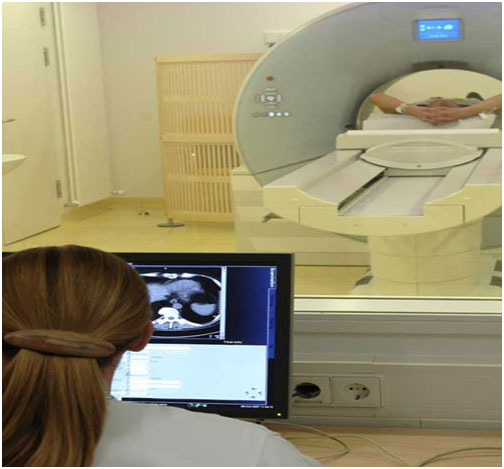
Tell your doctor if there’s a possibility you are pregnant and discuss any recent illnesses, medical conditions, medications you’re taking, and allergies. You will be instructed not to eat or drink anything for a few hours beforehand. If you have a known allergy to contrast material, your doctor may prescribe medications to reduce the risk of an allergic reaction. These medications must be taken 12 hours prior to your exam. Leave jewelry at home and wear loose, comfortable clothing. You may be asked to wear a gown.
What are the benefits vs. risks?
BenefitsComputed tomography angiography (CTA) uses an injection of iodine-rich contrast material and CT scanning to help diagnose and evaluate blood vessel disease or related conditions, such as aneurysms or blockages.
Tell your doctor if there’s a possibility you are pregnant and discuss any recent illnesses, medical conditions, medications you’re taking, and allergies. You will be instructed to not eat or drink anything several hours beforehand. If you have a known allergy to contrast material, your doctor may prescribe medications to reduce the risk of an allergic reaction. These medications must be taken 12 hours prior to your exam. Leave jewelry at home and wear loose, comfortable clothing. You may be asked to wear a gown. If you are breastfeeding, talk to your doctor about how to proceed.
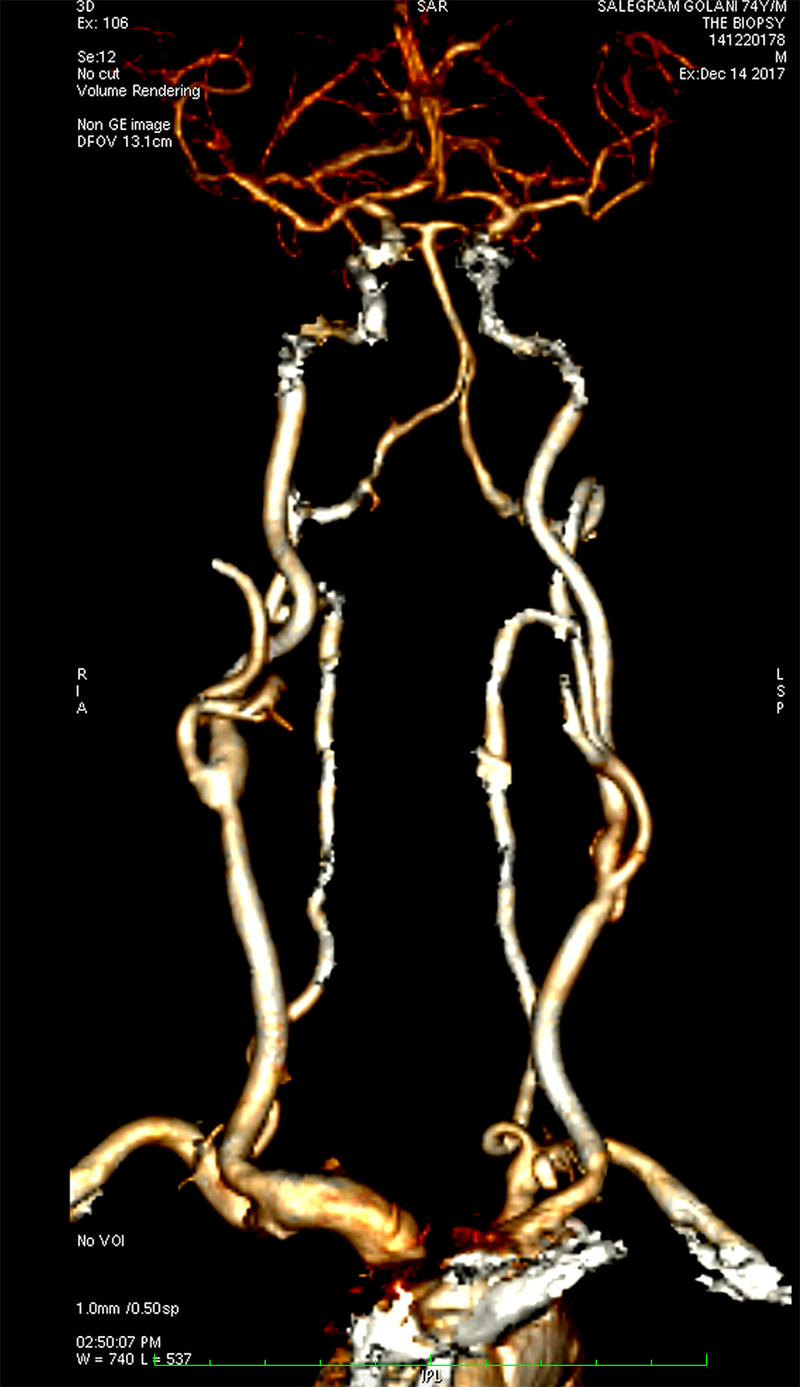
Angiography is a minimally invasive medical test that helps physicians diagnose and treat medical conditions. Angiography uses one of three imaging technologies and, in most cases, a contrast material injection is needed to produce pictures of blood vessels in the body.
Angiography is performed using:
CT angiography uses a CT scanner to produce detailed images of both blood vessels and tissues in various parts of the body. An iodine-rich contrast material (dye) is usually injected through a small catheter placed in a vein of the arm. A CT scan is then performed while the contrast flows through the blood vessels to the various organs of the body. After scanning, the images will be processed using a special computer and software and reviewed in different planes and projections.
What are some common uses of the procedure?
CT angiography is used to examine blood vessels and the organs supplied by them in various body parts, including:
Physicians use this test to diagnose and evaluate many diseases of blood vessels and related conditions such as:
CT, or CAT scans, are special X-ray tests that produce cross-sectional images of the body using X-rays and a computer. CT scans are also referred to as computerized axial tomography. CT was developed independently by a British engineer named Sir Godfrey Hounsfield and Dr. Alan Cormack. It has become a mainstay for diagnosing medical diseases. For their work, Hounsfield and Cormack were jointly awarded the Nobel Prize in 1979.
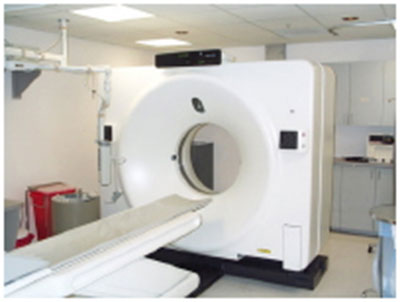 Picture of CT scan machine.
Picture of CT scan machine.
CT scan images allow the doctor to look at the inside of the body just as one would look at the inside of a loaf of bread by slicing it. This type of special X-ray, in a sense, takes "pictures" of slices of the body so doctors can look right at the area of interest. CT scans are frequently used to evaluate the brain, neck, spine, chest, abdomen, pelvis, and sinuses.
CT is a commonly performed procedure. Scanners are found not only in hospital X-ray departments, but also in outpatient offices.
CT has revolutionized medicine because it allows doctors to see diseases that, in the past, could often only be found at surgery or at autopsy. CT is noninvasive, safe, and well-tolerated. It provides a highly detailed look at many different parts of the body.
If one looks at a standard X-ray image or radiograph (such as a chest X-ray), it appears as if they are looking through the body. CT and MRI are similar to each other, but provide a much different view of the body than an X-ray does. CT and MRI produce cross-sectional images that appear to open the body up, allowing the doctor to look at it from the inside. MRI uses a magnetic field and radio waves to produce images, while CT uses X-rays to produce images. Plain X-rays are an inexpensive, quick test and are accurate at diagnosing things such as pneumonia, arthritis, and fractures. CT and MRI better to evaluate soft tissues such as the brain, liver, and abdominal organs, as well as to visualize subtle abnormalities that may not be apparent on regular X-ray tests.
People often have CT scans to further evaluate an abnormality seen on another test such as an X-ray or an ultrasound. They may also have a CT to check for specific symptoms such as pain or dizziness. People with cancer may have a CT to evaluate the spread of disease.
A head or brain CT is used to evaluate the various structures of the brain to look for a mass, stroke, area of bleeding, or blood vessel abnormality. It is also sometimes used to look at the skull.
A neck CT checks the soft tissues of the neck and is frequently used to study a lump or mass in the neck or to look for enlarged lymph nodes or glands.
CT of the chest is frequently used to further study an abnormality on a plain chest X-ray. It is also often used to look for enlarged lymph nodes.
Abdominal and pelvic CT looks at the abdominal and pelvic organs (such as the liver, spleen, kidneys, pancreas, and adrenal glands) and the gastrointestinal tract. These studies are often ordered to check for a cause of pain and sometimes to follow up on an abnormality seen on another test such as an ultrasound.
A sinus CT exam is used to both diagnose sinus disease and to detect a narrowing or obstruction in the sinus drainage pathway.
A spine CT test is most commonly used to detect a herniated disc or narrowing of the spinal canal (spinal stenosis) in people with neck, arm, back, and/or leg pain. It is also used to detect a fracture or break in the spine.
Different types of Computerized Tomography scans, or CT scans, are named for different uses or for what images they are trying to record. However, in most all cases, the basic technology of the CT itself stays the same. X-rays are taken to form three-dimensional images of body parts and organs for radiologists, specialists and doctors to examine.
CT scans can be as pinpointed and tiny as a detailed scan of a bile duct or as large as a more generalized full-body scan. In some cases, CT scans are often paired with Positron Emission Tomography scans, or PET scans, to produce results much more quickly than with conventional CT scans.
Refinements in CT scan technology are evolving constantly which bring even better picture quality. Newer CT scans called "spiral" or "helical" CT scans can provide more rapid and accurate visualization of internal organs.
These recently developed and accurate methods differ from the conventional CT. During the spiral CT the X-ray beam remains on continuously and rotates around the patient as the patient is moved through. This is a much more efficient technique that can reduce the scanning time of the entire abdomen, for example, from approximately two minutes using the conventional CT to 20-30 seconds using the spiral. The resulting images are three-dimensional rather than the two-dimensional images created with conventional techniques.
High resolution CT scans (HRCT) are used to accurately assess the lungs for inflammation and scarring.
There are many other types of CT scans. To find out more about a specific one, click any from the list below to see learn more:
Abdomen • Adrenal Glands • Appendix • Arm • Back • Bile Ducts • Bladder • Blood Vessels • Bone • Bowel • Brain • Breast • CAT • Cervical Spine • Cervix • Chest • Cranial • Fallopian Tube • Fetus • Full Body • Gallbladder • Head • Heart • Joint • Kidney • Leg • Liver • Lumbar Spine • Lymph Nodes • Neck • Overies • Pancreas • Pelvis • Penis • Prostate • Scrotum • Shoulder • Sinus • Skull • Spine • Spleen • Testicles • Thoracic Cavity • Thoracic Spine • Tumor • Urinary Tract • Uterus
Frequently Asked Questions
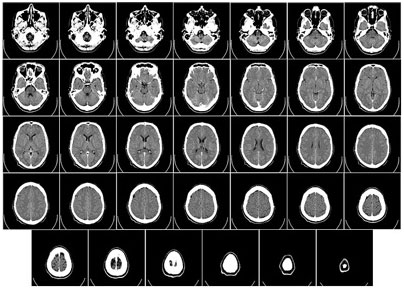
ABOVE: Computer Tomography (CT) of a head.
Computed tomography (CT or CAT scan) ranks as one of the top five medical developments in the last 40 years, according to most medical surveys. CT has proven so valuable as a medical diagnostic tool that the 1979 Nobel Prize in Medicine was awarded to the inventors.
Both CT and conventional x-rays take pictures of internal body structures. In conventional x-rays, the structures overlap. For example, the ribs overlay the lung and heart. In an x-ray, structures of medical concern are often obscured by other organs or bones, making diagnosis difficult.
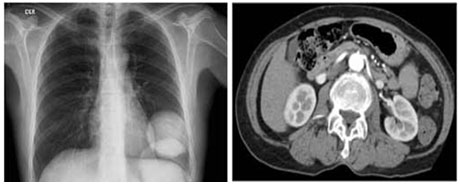
In a CT image, overlapping structures are eliminated, making the internal anatomy more apparent.
During CT imaging, an x-ray tube rotates around the patient so that multiple images are collected from many angles. These images are stored in a computer that analyzes them to create a new image with the overlying structures removed.
CT images allow radiologists and other physicians to identify internal structures and see their shape, size, density and texture. This detailed information can be used to determine if there is a medical problem as well as the extent and exact location of the problem, and other important details. The images can also show if no abnormality is present.
A CT scan that shows no abnormality still provides useful data. The information aids a diagnostician by focusing attention away from unnecessary medical concerns.
Modern CT scanners acquire this information in seconds – sometimes in fractions of a second – depending on the examination.
BenefitsBenefits of CT include more effective medical management by:
In an emergency room, patients can be scanned quickly so doctors can rapidly assess their condition. Emergency surgery might be necessary to stop internal bleeding. CT images show the surgeons exactly where to operate. Without this information, the success of surgery is greatly compromised. The risk of radiation exposure from CT is very small compared to the benefits of a well-planned surgery.
CT scanning provides medical information that is different from other imaging examinations, such as ultrasound, MRI, SPECT, PET or nuclear medicine. Each imaging technique has advantages and limitations. The principal advantages of CT are:
3D movies, 3D books, 3D printing and now 3D dental scans? Do I have to wear those funny looking glasses? Will I get motion sickness or up close and personal with all sorts of creatures? Don’t get yourself into dental distress! 3D dental scans are the newest advancement in technology that your dentist can use to get a good idea of what’s really going on with your chompers — no silly glasses needed.
 3D Dental Scans Today
3D Dental Scans Today
A 3D dental scan, also known as Cone Beam Computed Tomography (CBCT), was first used in its archaic form by German dentist, Otto Walkoff, who made the first dental radiograph ever. He recorded it with a 25-minute exposure using a glass receptor in his mouth while lying on the floor of his dental treatment room. Thankfully, dentistry has come a long way since then, and the quality of the images produced have, too.
Today, 3D scans are much quicker and significantly more comfortable. 3D dental imaging uses an X-ray arm that rotates around your head. While rotating, it captures multiple images and sends them to a computer where the computer puts the images together in 3D format. Dentists get a very clear and concise picture of things that you can’t see with the naked eye, which makes it easier for them to safely diagnose and even customize your treatment. Scanners like the Prexion 3-D (what we use!) are top of the class when it comes to 3D dental imaging. The Prexion takes a crystal clear 1:1 image of your teeth, mouth and jaw, which gives your dentist incredibly accurate measurements. These scans can even be used in early detection of dental conditions which could save you a lot of appointments in the long run. 3D dental scans can also be used when planning for surgery, evaluating the jaw or sinuses, and even reconstructive surgery such as dental implants
If you think you may be a candidate for dental implants, or would like some more information on 3D scans and what they can do for you and your specific situation, ask your dentist! If you’re ready to take the next steps, and are looking for a dentist in the West Chester area, contact us or give us a call at 610-696-3371 to schedule your 3D Diagnostic Scan!
X-rays are a very energetic form of electromagnetic radiation that can be used to take images of the human body.
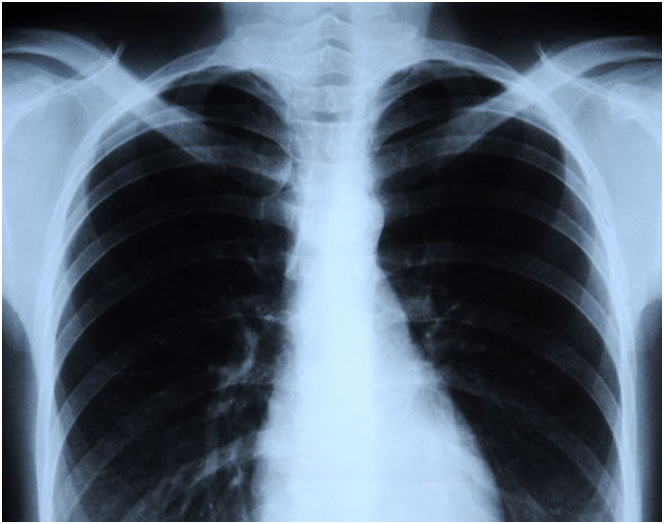
X-rays are a form of electromagnetic radiation, as are radio waves, infrared radiation, visible light, ultraviolet radiation and microwaves. One of the most common and beneficial uses of X-rays is for medical imaging. X-rays are also used in treating cancer and in exploring the cosmos.
Electromagnetic radiation is transmitted in waves or particles at different wavelengths and frequencies. This broad range of wavelengths is known as the electromagnetic spectrum. The EM spectrum is generally divided into seven regions in order of decreasing wavelength and increasing energy and frequency. The common designations are: radio waves, microwaves, infrared (IR), visible light, ultraviolet (UV), X-rays and gamma-rays.
The electromagnetic spectrum is generally divided into seven regions, in order of decreasing wavelength and increasing energy and frequency: radio waves, microwaves, infrared, visible light, ultraviolet, X-rays and gamma rays.
X-rays are roughly classified into two types: soft X-rays and hard X-rays. Soft X-rays fall in the range of the EM spectrum between (UV) light and gamma-rays. Soft X-rays have comparatively high frequencies — about 3 × 1016 cycles per second, or hertz, to about 1018 Hz — and relatively short wavelengths — about 10 nanometers (nm), or 4 × 10−7 inches, to about 100 picometers (pm), or 4 × 10−8 inches. (A nanometer is one-billionth of a meter; a picometer is one-trillionth of a meter.) Hard X-rays have frequencies of about 1018 Hz to higher than 1020 Hz and wavelengths of about 100 pm (4 × 10−9 inches) to about 1 pm (4 × 10−11 inches). Hard X-rays occupy the same region of the EM spectrum as gamma-rays. The only difference between them is their source: X-rays are produced by accelerating electrons, while gamma-rays are produced by atomic nuclei.
X-rays were discovered in 1895 by Wilhelm Conrad Röentgen, a professor at Würzburg University in Germany. According to the Nondestructive Resource Center's "History of Radiography" Web page, Röentgen noticed crystals near a high-voltage cathode-ray tube exhibiting a fluorescent glow, even when he shielded them with dark paper. Some form of energy was being produced by the tube, and it was penetrating the paper and causing the crystals to glow. Röentgen called the unknown energy "X-radiation." Experiments showed that this radiation could penetrate soft tissues but not bone, and would produce shadow images on photographic plates.
For this discovery, Röentgen was awarded the very first Nobel Prize in Physics, in 1901. During World War I, X-rays were already being used for medical purposes.
According to NobelPrize.org, "X-rays are produced when electrons strike a metal target. The electrons are liberated from the heated filament and accelerated by a high voltage towards the metal target." When the electrons strike the target, their energy is converted to X-rays.
X-rays can also be produced by a synchrotron, a type of particle accelerator that causes charged particles to move in a closed, circular path. When high-speed electrons are forced to move in a circular path by a magnetic field, the angular acceleration causes the particles to emit photons. If the energy is great enough, the electrons will emit X-rays.
Synchrotron radiation was seen for the first time at General Electric in the United States in 1947, according to the European Synchrotron Radiation Facility. This radiation was considered a nuisance because it caused the particles to lose energy, but it was later recognized in the 1960s as light with exceptional properties that overcame the shortcomings of X-ray tubes. One interesting feature of synchrotron radiation is that it is polarized; that is, the electric and magnetic fields of the photons all oscillate in the same direction, which can be either linear or circular.
Due to their ability to penetrate certain materials, X-rays are used for a number of nondestructive evaluation and testing (NDE/NDT) applications, particularly for identifying flaws or cracks in structural components. According to the NDT Resource Center, "Radiation is directed through a part and onto [a] film or other detector. The resulting shadowgraph shows the internal features" and whether the part is sound.
X-rays are also essential for transportation security inspections of cargo, luggage and passengers. Electronic imaging detectors allow for real-time visualization of the content of packages and items that passengers might carry on their persons.
The original use of X-rays was for imaging bones, which were easily distinguishable from soft tissues on the film that was available at that time. However, more accurate focusing systems and more sensitive detection methods, such as improved photographic films and electronic imaging sensors, have made it possible to distinguish increasingly fine detail and subtle differences in tissue density, while using much lower exposure levels. Additionally, computed tomography (CT) combines multiple X-ray images into a 3D model of a region of interest. The U.S. Food and Drug Administration states that X-ray imaging exams are recognized as a valuable medical tool for a wide variety of examinations and procedures. They are used as a noninvasive and painless method for diagnosing disease and monitoring therapy, and supporting medical and surgical treatment planning. They are also used in guiding medical personnel as they insert catheters, stents or other devices into the body; treat tumors; or remove blood clots or other blockages.
Radiation therapy uses high-energy radiation to kill cancer cells by damaging their DNA. However, the treatment can damage normal cells as well as cancer cells. Therefore, the National Cancer Institute recommends that treatment must be carefully planned to minimize side effects.
According to the U.S. Environmental Protection Agency, ionizing radiation from X-rays deposits a large amount of energy into a small area, enough energy to strip electrons completely way from atoms, thus altering their chemical properties and breaking molecular bonds. In sufficient doses, this can damage or destroy cells. While this cell damage can cause cancer, it can also be used to fight it. By directing X-rays at cancerous tumors, the abnormal cells can be killed.
According to Robert Patterson, professor of astronomy at Missouri State University, celestial sources of X-rays include close binary systems containing black holes or neutron stars. In these systems, the more massive and compact stellar remnant can strip material from its companion star forming a disk of extremely hot X-ray-emitting gas as it spirals inward. Additionally, supermassive black holes at the centers of spiral galaxies can emit X-rays as they absorb stars and gas clouds that fall within their gravitational reach.
X-ray telescopes use low-angle reflections to focus these high-energy photons that would otherwise pass through normal telescope mirrors. Because the Earth's atmosphere blocks most X-rays, observations are typically conducted using high-altitude balloons or orbiting telescopes.
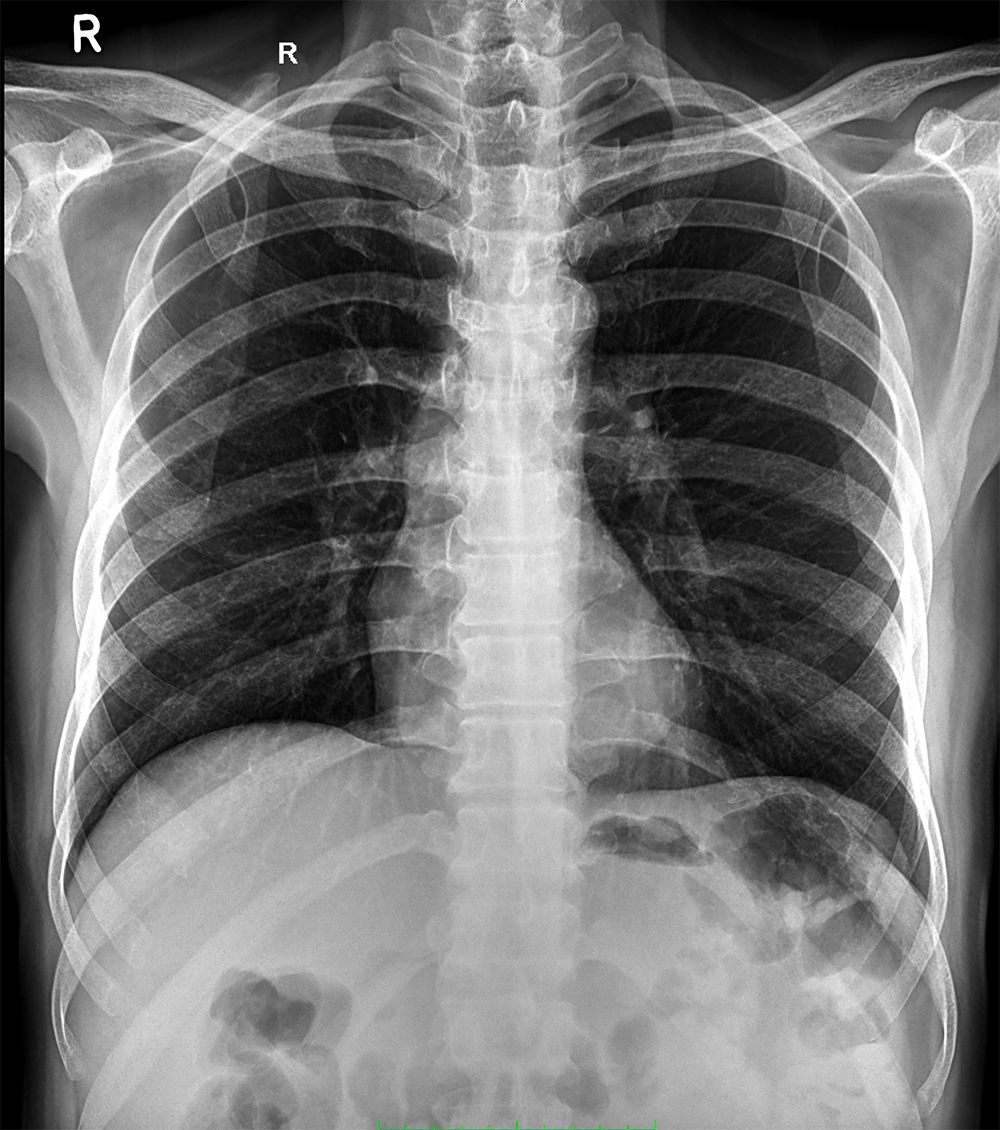
X-ray is a shorthand for X-radiation. Discovered and named by Wilhelm Rontgen, x-rays can neither be see with the naked eyes nor can they be felt. The main aim behind the discovery of this technology was to study the internal parts of the human body, which cannot be seen otherwise. The human system is a complex structure of mass that comprises of a plethora of organs and bones which perform a colossal range of day-to-day activities. Due to some internal or external factors, the system faces issues. This is where an X-ray test helps in detecting problems by producing images. From dental to chest, abdomen to ankle every part of the body can be studied with the help of X-ray.
Types of X-raysMedical science recognizes different types of X-rays. These are as follows:-
Standard Computed TomographyA standard computed tomography or otherwise known as computerized axial tomography is performed in a hospital or at a radiologist’s office. The test aids in obtaining detailed images of areas inside the body, typically for the diagnosis of circulatory system such as blood vessel aneurysms, blood clots, and coronary artery disease.
Kidney, Ureter, and Bladder X-rayAlso known as KUB X-Rays, it is performed to assess the abdominal area for causes of abdominal pain, or to assess the organs and structures of the urinary and/or gastrointestinal (GI) system. A KUB X-ray is practically the first diagnostic procedure used for the assessment of the urinary system.
Teeth and bones X-raysThese x-rays give a high level of detail about bones, teeth, and supporting tissues of the mouth. These X-rays enable dentists to look at the tooth roots, the status of the developing tooth, and health of the bony areas.
Chest X-raysA small test that uses radiation to produce images of the bones, tissues, and organs of the body. The doctor prescribes a chest X-ray for a number of reasons like shortness of breath, fever, chest pain, and persistent cough. It is a quick and effective test that aids in analyzing the health of some of the most vital organs.
Lungs X-raysThis type of X-Ray is done to assess the lungs by comparing the upper, middle & lower zones of the lungs. The asymmetry of lung density is represented as either abnormal whiteness (increased density) or abnormal blackness (decreased density). Once you spot the asymmetry, the next step is to decide which side is abnormal. If there is an area that is different from the surrounding ipsilateral lung, then this is likely to be the abnormal area.
Abdomen X-raysAn imaging test to look at structures and organs in the belly, this x-ray encompasses the small and large intestines, liver, and stomach. It is one of the first tests to find a cause of nausea, stomach pain, vomiting, and swelling. Other tests like intravenous pyelography, ultrasound, and CT scan are also done to find more specific problems.
The X-Ray tests are done to check for broken bones and abnormal activities in the body. It is mostly a quick & painless procedure and a very effective way of looking at the bones and other body parts. Your doctor may prescribe you an X-Ray if you experience prolonged explainable pain in your body; as an X-ray produces images of the affected organs, bones, and tissues of the body. Also, a chest X-Ray may be used to detect pneumonia.
Here are a variety of problems which can be detected with the help of an X-Ray:
Different types of X-rays speak of different set of procedures and come with their own set of rules and regulations as well. For instance, you need to fast for about 12 hours for getting an exam done in the case of most X-rays. In the case of a dental X-ray, no such preparations are needed. However, there are some rules that remain the same – remove all body piercings, jewellery and other metals before the X-ray. In some special cases, you may also be asked to discontinue some medications, such as during pregnancy or other medical conditions, as radiation can serve harmful to the body.
The test is taken by a radiology technologist one from the back and the other one from the side of the body. In an emergency, one image is taken from the front. During the exam, you have to hold your breath so that your chest stays completely still. When the test is completed, you have to wait until the radiologist confirms all the pictures have been obtained. Some hospitals have portable x-rays equipment. If a test is done with a portable x-ray machine, you need to be placed in the correct position by the nurse.
If you’re worried about the effect of radiation exposure, then most physicians state that X-rays are safe. The kind of radiations sent to the body are safe of the internal system as well. In some cases, a special substance is given in addition to throwing radiation waves, as the combination helps in viewing structures which a normal scan may not be able to reveal. At the same time, it is important to note, and as stated in the paragraph above, X-ray test is not recommended to pregnant women. This is because the rays of the radiation process are harmful for the developing baby. He/she, in the event of strong radiation may develop lifetime abnormalities.
To conclude, different types of X-rays are used for detecting, diagnosing, and analyzing different body conditions. Each of these tests, as listed above, has its own role to play. They are highly effective and quite safe as well.
The discovery of X-rays and the invention of CT represented major advances in medicine. X-ray imaging exams are recognized as a valuable medical tool for a wide variety of examinations and procedures. They are used to:
X-ray imaging (CT, fluoroscopy, and radiography) exams should be performed only after careful consideration of the patient's health needs. They should be performed only when the referring physician judges them to be necessary to answer a clinical question or to guide treatment of a disease. The clinical benefit of a medically appropriate X-ray imaging exam outweighs the small radiation risk. However, efforts should be made to help minimize this risk.
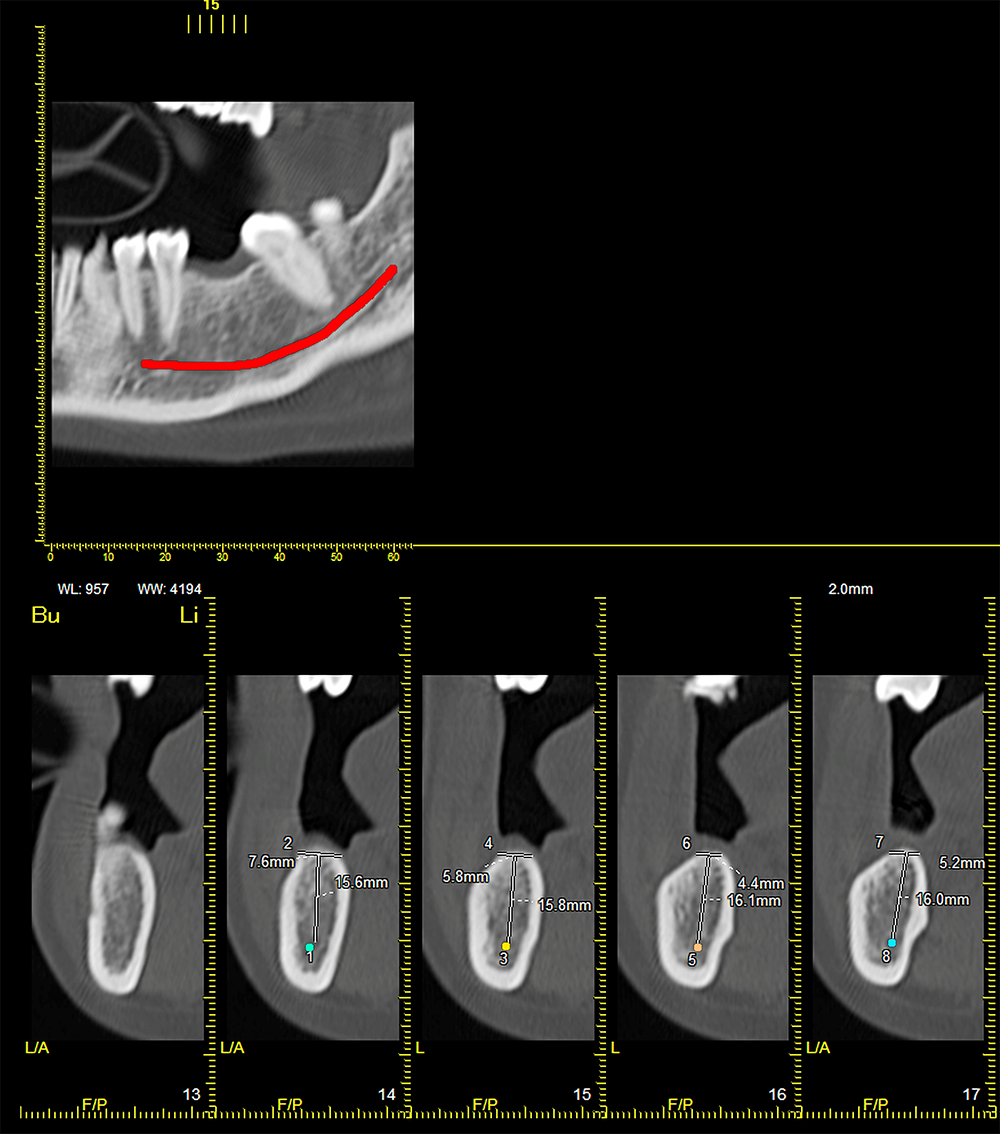
OPG – Orthopantomogram is one amongst the dental connected x-ray that’s used for diagnostic and treatment purpose. It’s taken to view the complete mouth radiography, that shows upper and lower jaw with teeth, additionally shows temporomandibular joint.
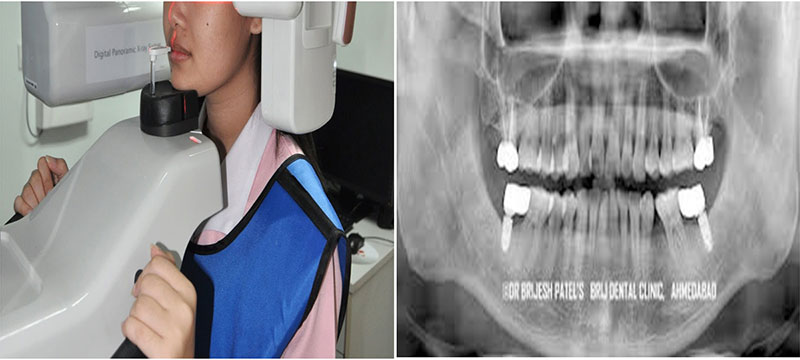
Dentist suggests taking an OPG once it’s required.
It’s required to detect dental connected disease.
It is additionally taken for planning the orthodontic treatment.
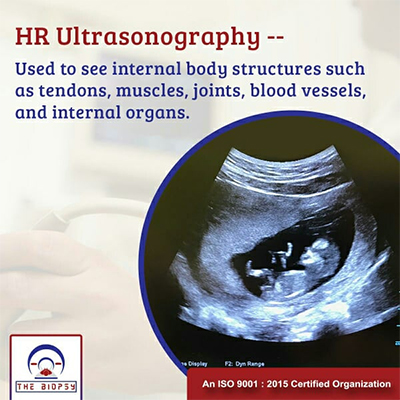
Ultrasound imaging uses sound waves to produce pictures of the inside of the body. It is used to help diagnose the causes of pain, swelling and infection in the body’s internal organs and to examine a baby in pregnant women and the brain and hips in infants. It’s also used to help guide biopsies, diagnose heart conditions, and assess damage after a heart attack. Ultrasound is safe, noninvasive, and does not use ionizing radiation.
This procedure requires little to no special preparation. Your doctor will instruct you on how to prepare, including whether you should refrain from eating or drinking beforehand. Leave jewelry at home and wear loose, comfortable clothing. You may be asked to wear a gown.
Ultrasound is safe and painless, and produces pictures of the inside of the body using sound waves. Ultrasound imaging, also called ultrasound scanning or sonography, involves the use of a small transducer (probe) and ultrasound gel placed directly on the skin. High-frequency sound waves are transmitted from the probe through the gel into the body. The transducer collects the sounds that bounce back and a computer then uses those sound waves to create an image. Ultrasound examinations do not use ionizing radiation (as used in x-rays), thus there is no radiation exposure to the patient. Because ultrasound images are captured in real-time, they can show the structure and movement of the body's internal organs, as well as blood flowing through blood vessels.
Ultrasound imaging is a noninvasive medical test that helps physicians diagnose and treat medical conditions.
Conventional ultrasound displays the images in thin, flat sections of the body. Advancements in ultrasound technology include three-dimensional (3-D) ultrasound that formats the sound wave data into 3-D images.
A Doppler ultrasound study may be part of an ultrasound examination.
Doppler ultrasound, also called color Doppler ultrasonography, is a special ultrasound technique that allows the physician to see and evaluate blood flow through arteries and veins in the abdomen, arms, legs, neck and/or brain (in infants and children) or within various body organs such as the liver or kidneys.
There are three types of Doppler ultrasound:
Ultrasound examinations can help to diagnose a variety of conditions and to assess organ damage following illness.
Ultrasound is used to help physicians evaluate symptoms such as:
Ultrasound is a useful way of examining many of the body's internal organs, including but not limited to the:
Doppler ultrasound images can help the physician to see and evaluate:
With knowledge about the speed and volume of blood flow gained from a Doppler ultrasound image, the physician can often determine whether a patient is a good candidate for a procedure like angioplasty.
You should wear comfortable, loose-fitting clothing for your ultrasound exam. You may need to remove all clothing and jewelry in the area to be examined.
You may be asked to wear a gown during the procedure.
Preparation for the procedure will depend on the type of examination you will have. For some scans your doctor may instruct you not to eat or drink for as many as 12 hours before your appointment. For others you may be asked to drink up to six glasses of water two hours prior to your exam and avoid urinating so that your bladder is full when the scan begins.
Ultrasound scanners consist of a console containing a computer and electronics, a video display screen and a transducer that is used to do the scanning. The transducer is a small hand-held device that resembles a microphone, attached to the scanner by a cord. Some exams may use different transducers (with different capabilities) during a single exam. The transducer sends out high-frequency sound waves (that the human ear cannot hear) into the body and then listens for the returning echoes from the tissues in the body. The principles are similar to sonar used by boats and submarines.
The ultrasound image is immediately visible on a video display screen that looks like a computer or television monitor. The image is created based on the amplitude (loudness), frequency (pitch) and time it takes for the ultrasound signal to return from the area within the patient that is being examined to the transducer (the device placed on the patient's skin to send and receive the returning sound waves), as well as the type of body structure and composition of body tissue through which the sound travels. A small amount of gel is put on the skin to allow the sound waves to travel from the transducer to the examined area within the body and then back again. Ultrasound is an excellent modality for some areas of the body while other areas, especially air-filled lungs, are poorly suited for ultrasound.
Ultrasound imaging is based on the same principles involved in the sonar used by bats, ships and fishermen. When a sound wave strikes an object, it bounces back, or echoes. By measuring these echo waves, it is possible to determine how far away the object is as well as the object's size, shape and consistency (whether the object is solid or filled with fluid).
In medicine, ultrasound is used to detect changes in appearance, size or contour of organs, tissues, and vessels or to detect abnormal masses, such as tumors.
In an ultrasound examination, a transducer both sends the sound waves into the body and receives the echoing waves. When the transducer is pressed against the skin, it directs small pulses of inaudible, high-frequency sound waves into the body. As the sound waves bounce off internal organs, fluids and tissues, the sensitive receiver in the transducer records tiny changes in the sound's pitch and direction. These signature waves are instantly measured and displayed by a computer, which in turn creates a real-time picture on the monitor. One or more frames of the moving pictures are typically captured as still images. Short video loops of the images may also be saved.
Doppler ultrasound, a special application of ultrasound, measures the direction and speed of blood cells as they move through vessels. The movement of blood cells causes a change in pitch of the reflected sound waves (called the Doppler effect). A computer collects and processes the sounds and creates graphs or color pictures that represent the flow of blood through the blood vessels.
For most ultrasound exams, you will be positioned lying face-up on an examination table that can be tilted or moved. Patients may be turned to either side to improve the quality of the images.
After you are positioned on the examination table, the radiologist (a physician specifically trained to supervise and interpret radiology examinations) or sonographer will apply a warm water-based gel to the area of the body being studied. The gel will help the transducer make secure contact with the body and eliminate air pockets between the transducer and the skin that can block the sound waves from passing into your body. The transducer is placed on the body and moved back and forth over the area of interest until the desired images are captured.
There is usually no discomfort from pressure as the transducer is pressed against the area being examined. However, if scanning is performed over an area of tenderness, you may feel pressure or minor pain from the transducer.
Doppler sonography is performed using the same transducer.
Rarely, young children may need to be sedated in order to hold still for the procedure. Parents should ask about this beforehand and be made aware of food and drink restrictions that may be needed prior to sedation.
Once the imaging is complete, the clear ultrasound gel will be wiped off your skin. Any portions that are not wiped off will dry quickly. The ultrasound gel does not usually stain or discolor clothing.In some ultrasound studies, the transducer is attached to a probe and inserted into a natural opening in the body. These exams include:
Transesophageal echocardiogram. The transducer is inserted into the esophagus to obtain images of the heart.
Transrectal ultrasound. The transducer is inserted into a man's rectum to view the prostate.
Transvaginal ultrasound. The transducer is inserted into a woman's vagina to view the uterus and ovaries.
Ultrasound examinations are painless and easily tolerated by most patients.
Ultrasound exams in which the transducer is inserted into an opening of the body may produce minimal discomfort.
If a Doppler ultrasound study is performed, you may actually hear pulse-like sounds that change in pitch as the blood flow is monitored and measured.
Most ultrasound examinations are completed within 30 minutes, although more extensive exams may take up to an hour.
When the examination is complete, you may be asked to dress and wait while the ultrasound images are reviewed.
After an ultrasound examination, you should be able to resume your normal activities immediately.
A radiologist, a physician specifically trained to supervise and interpret radiology examinations, will analyze the images and send a signed report to your primary care physician, or to the physician or other healthcare provider who requested the exam. Usually, the referring physician or health care provider will share the results with you. In some cases, the radiologist may discuss results with you at the conclusion of your examination.
Follow-up examinations may be necessary. Your doctor will explain the exact reason why another exam is requested. Sometimes a follow-up exam is done because a potential abnormality needs further evaluation with additional views or a special imaging technique. A follow-up examination may also be necessary so that any change in a known abnormality can be monitored over time. Follow-up examinations are sometimes the best way to see if treatment is working or if a finding is stable or changed over time.
For standard diagnostic ultrasound, there are no known harmful effects on humans.
Ultrasound waves are disrupted by air or gas; therefore ultrasound is not an ideal imaging technique for air-filled bowel or organs obscured by the bowel. In most cases, barium exams, CT scanning, and MRI are the methods of choice in such a setting.
Large patients are more difficult to image by ultrasound because greater amounts of tissue attenuate (weaken) the sound waves as they pass deeper into the body and need to be returned to the transducer for analysis.
Ultrasound has difficulty penetrating bone and, therefore, can only see the outer surface of bony structures and not what lies within (except in infants who have more cartilage in their skeletons than older children or adults). For visualizing internal structure of bones or certain joints, other imaging modalities such as MRI are typically used.
Abdominal Ultrasound Imaging
An abdominal ultrasound is a useful way of examining internal organs, including the liver, gallbladder, spleen, pancreas, kidneys, and bladder. Because US images are captured in real time, they can show movement of internal tissues and organs and enable physicians to see blood flow. This can help to diagnose a variety of conditions and to assess damage caused by illness.
Ultrasound imaging is used extensively for evaluating the kidneys, liver, gallbladder, pancreas, spleen, and blood vessels of the abdomen. Because it provides real-time images, it can also be used to:
The patient is positioned on an examination table, and a clear gel is applied to the abdomen to help the transducer make secure contact with the skin. The sound waves produced by the transducer cannot penetrate air, so the gel helps to eliminate air pockets between the transducer and the skin. The sonographer or radiologist then presses the transducer firmly against the skin and sweeps it back and forth to image the area of interest.
When the examination is complete, the patient may be asked to dress and wait while the ultrasound images are reviewed, either on film or on a monitor. Often, though, the sonographer or radiologist is able to review the ultrasound images in real time as there may be varying degrees of discomfort from pressure as the radiologist or sonographer guides the transducer over your abdomen, especially if you are required to have a full bladder. The examination usually takes less than 30 minutes.
Pelvic ultrasound is most often used to examine the uterus and ovaries and, during pregnancy, to monitor the health and development of the embryo or fetus. In men, a pelvic ultrasound usually focuses on the bladder and the prostate gland.
Millions of expectant parents have seen the first "picture" of their unborn child thanks to pelvic ultrasound examinations of the uterus and fetus (see the Ultrasound-Obstetric page). However, monitoring of fetal development is not the only reason for a pelvic ultrasound exam.
For women, ultrasound examinations can help determine the causes of pelvic pain, abnormal bleeding, or other menstrual problems. Ultrasound images can also help to identify palpable masses such as ovarian cysts and uterine fibroids, as well as ovarian or uterine cancers. Sonohysterography (saline infusion sonography) is a procedure in which sterile saline is injected into the uterus while a transvaginal sonogram is performed. The purpose is to distend the uterine cavity (endometrial cavity) to look for polyps, fibroids, or cancer, especially in patients with abnormal uterine bleeding. Other indications include evaluation of the uterine cavity looking for uterine anomalies (abnormal uterine shapes since birth) or scars. The saline outlines the lesion and allows for easy visualization and measurement. Some physicians also use sonohysterography for patients with infertility. Saline and air are injected into the uterus and the physician looks for air bubbles passing through the fallopian tubes, which would indicate patency of the fallopian tubes. In men, pelvic ultrasound is a valuable tool for evaluating the prostate gland, as well as for evaluating the seminal vesicles.
A pelvic ultrasound exam can help to identify stones, tumors and other disorders in the urinary bladder in both men and women. Because ultrasound provides real time images, it can also be used to guide procedures, such as needle biopsies, in which a needle is used to sample cells from an abnormal area for laboratory testing. Doppler sonography is another method of ultrasound that can be used to evaluate blood flow in pelvic vessels.
There are three methods of performing pelvic ultrasound: abdominal (transabdominal), vaginal (transvaginal, endovaginal) in women, and rectal (transrectal) in men. The same principles of high-frequency sound apply in each technique.
For the transabdominal approach, the patient has a full urinary bladder and is positioned on an examination table. A clear gel is applied to the lower abdomen to help the transducer make secure contact with the skin. The sound waves produced by the transducer cannot penetrate air, so the gel helps to eliminate air pockets between the transducer and the skin. With transabdominal ultrasound, you will lie on your back on an examining table. The sonographer will spread some gel on your skin and then presses the transducer firmly against the skin and sweeps it back and forth to image the pelvic organs. Doppler sonography can be performed through the same transducer. There may be varying degrees of discomfort from pressure as the transducer is moved over your abdomen, especially if you are required to have a full bladder.
Transvaginal ultrasound involves the insertion of the transducer into the vagina after the patient empties her bladder and is performed very much like a gynecologic exam. The tip of the transducer is smaller than the standard speculum used when performing a Pap test. A protective cover is placed over the transducer, lubricated with a small amount of gel, and then inserted into the vagina. Only two to three inches of the transducer end are inserted into the vagina. The images are obtained from different orientations to get the best views of the uterus and ovaries. Doppler sonography can be performed through the transvaginal transducer, which is the same transducer used during sonohysterography. Transvaginal ultrasound is usually performed with the patient lying on her back and with her feet in stirrups as during a gynecologic exam.
With transvaginal ultrasound, although the examination is often performed to look for a cause of pelvic pain, the sonogram itself should not be painful or significantly increase your discomfort. A vaginal sonogram is usually more comfortable than a manual gynecologic examination.
The prostate gland is located directly in front of the rectum, so the ultrasound exam is performed transrectally. A protective cover is placed over the transducer, lubricated, and then placed into the rectum so the sound need only travel a short distance. The images are obtained from different orientations to get the best view of the prostate gland. Ultrasound of the prostate is most often performed with the patient lying with his left side down on the table and with his knees bent up slightly toward the chest.
If a suspicious lesion is identified with ultrasound or with a rectal examination, an ultrasound-guided biopsy can be performed. This procedure involves advancing a needle into the prostate gland while the radiologist watches the needle placement with ultrasound. A small amount of tissue is taken for microscopic examination.
If no biopsy is required, transrectal ultrasound examination of the prostate is similar in discomfort to a rectal exam performed by your doctor. If a biopsy is performed, additional discomfort, due to the needle insertion, is usually minimal because the rectal wall is relatively insensitive in the region of the prostate.
Each method has its advantages. The transabdominal approach offers an expanded view of the entire pelvis, showing where one internal structure is in relation to another. Since the transducer is brought closer to the area being examined in the transvaginal and transrectal approaches, improved visualization may be achieved. Thus, it can be helpful in locating the embryonic heartbeat in an early pregnancy, evaluating the uterine texture, or measuring a cyst in an ovary. Your physician or radiologist will decide whether one or a combination of approaches is best for your particular case.
When the examination is complete, the patient may be asked to dress and wait while the ultrasound images are reviewed, either on film or on a monitor. Often, though, the sonographer or radiologist is able to review the ultrasound images in real time as they are acquired, and the patient can be released immediately. Almost all examinations take less than 30 minutes.
Obstetric ultrasound refers to the specialized use of sound waves to visualize and thus determine the condition of a pregnant woman and her embryo or fetus.
Obstetric ultrasound should be performed only when clinically indicated. Some indications may be:
You will be asked to lie on your back or side. You will also be asked to expose your lower abdominal area. The sonographer or radiologist then spreads a warm water-soluble gel over your lower abdomen. This gel allows better transmission of the sound waves by making it easier to move the transducer over your abdomen and by sending the sound beam directly into the body without the interference from even a tiny amount of air on the skin. The transducer emits high-frequency sound waves as the sonographer or radiologist moves it over your abdomen. The transducer also detects the echoes that bounce off anatomic structures as reflections. Sometimes the radiologist determines that a transvaginal scan will need to be performed. Instead of a transducer being moved over your abdomen, the high-frequency waves will be emitted by a transducer placed in the vagina. This technique often provides improved, more detailed images of the uterus and ovaries. It is especially useful in early pregnancy. With this approach the urinary bladder needs to be empty. Shown is an example of a transvaginal transducer. Only two to three inches of the transducer are inserted into the vagina. The rest of the transducer is a handle for use by the operator.
The obstetric ultrasound examination takes about 20 minutes. This is a painless procedure. There may be varying degrees of discomfort from pressure as the sonographer or radiologist guides the transducer over your abdomen, especially if you are required to have a full bladder. At times the sonographer may have to press more firmly to get closer to the embryo or fetus to better visualize the structure. This discomfort is temporary. Also, you may dislike the feeling of the water-soluble gel applied to your abdomen. With transvaginal scanning, there may be minimal discomfort as the transducer is moved in the vagina.
Carotid and Abdominal Aorta Ultrasound Imaging
Ultrasound of the carotid arterial system provides a fast, noninvasive means of identifying blockages of blood flow in the neck arteries to the brain that might produce a stroke or mini-stroke. Ultrasound of the abdominal aorta is primarily used to evaluate for an aneurysm which is an abnormal enlargement of the aorta usually from atherosclerotic disease.
The patient is positioned on an examination table that can tilt and move. A clear gel is applied to the area that will be examined. The gel helps the transducer make a secure contact and eliminates air pockets between the transducer and the skin, since the sound waves cannot penetrate air. The sonographer or radiologist then presses the transducer firmly against the skin and sweeps along the area of interest, reviewing the images on the monitor and capturing "snapshots" as required.
When the examination is complete, the patient may be asked to dress and wait while the ultrasound images are reviewed, either on film or on a monitor. Often, though, the sonographer or radiologist is able to review the ultrasound images in real time as they are acquired, and the patient can be released immediately. Most ultrasound studies are fast and easy. You will lie on your back on an examining table that may be tilted or moved to provide access to the area that will be imaged. The sonographer or radiologist will spread some gel on your skin and then press the transducer firmly against your body, moving it until the desired images are captured. Most exams take less than 30 minutes; however, more complicated examinations may take somewhat longer.
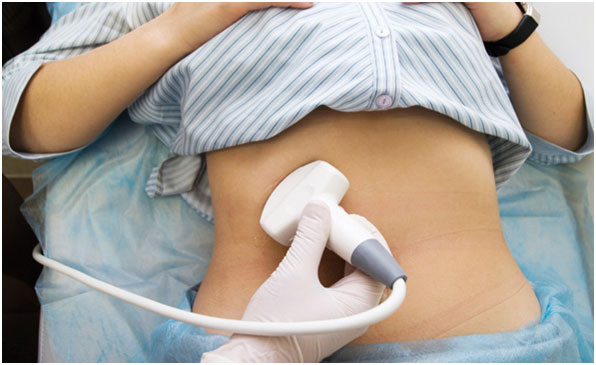
Like many medical terms, the phrase “abdominal ultrasound” can cause some anxiety. Right? So, if you’re not sure what an ultrasound entails, you’re in the right place. We’re here to take the worry (or maybe just the uncertainty) out of your next ultrasound. Without going into extreme depth, an ultrasound is a simple imaging modality that is used to take detailed images of the inside of your body, in this case the abdomen, to confirm if there has been any change to your internal organs or tissues caused by illness or disease. Ultrasounds are 100% safe and are covered by most insurance companies (Whew!). So, let’s explore a little more about abdominal ultrasounds and learn what to expect if you’re referred for an ultrasound.
The first question most patients have is usually a simple one – what in the world is an abdominal ultrasound? An abdominal ultrasound is a test that results in images of the upper abdominal viscera, or solid organs. These images are needed to record by way of real time imaging the organs in the abdomen like the kidneys, gallbladder, pancreas, or liver. Sometimes the blood vessels that are associated or connected to these organs can also be examined with an ultrasound like the aorta for example.
Because the images are taken in real time, kind of like watching live TV, sonologists and sonographers are able to scan in multiple planes to scan through each organ from different perspectives. The medical community has vastly improved with the addition of diagnostic ultrasounds. Ultrasounds are simple, easy non-invasive tests.
The most common use of an abdominal ultrasound is to check the morphology (which is the form and structure of main internal solid organs) in your abdominal area. The organs usually assessed are the kidneys, liver, gallbladder, pancreas, spleen, and various surrounding blood vessels. Ultrasounds produce images of these organs to ensure that no abnormalities exist.
Your doctor may also recommend an abdominal ultrasound if you are experiencing any abdominal pain or distention in an attempt to diagnose the cause of your pain. For instance, blood tests may show that your liver is not functioning properly, so an abdominal ultrasound will be performed to assess the size, shape and appearance of that particular organ. The liver could be examined for the cause of jaundice, to assess the liver for fatty infiltration and / or a mass or lesion.
If your physician performs a physical examination and discovers that one of your abdominal organs is enlarged, an exploratory ultrasound will be ordered. Enlarged organs indicate an abnormality
Abdominal ultrasounds can also be used to detect the presence of gallstones, kidney stones, or blocked bile ducts. Additionally, if you have (or there is a possibility of having) an aneurysm of the aorta, ultrasounds are used to find, measure, and monitor the aneurysm. These aneurysms may appear as a large, pulsing bump in the abdomen but many times this dilatation of the aorta can go unnoticed and is only seen when having an abdominal ultrasound usually for some other reason.
Abdominal ultrasounds are also useful tools in the field of oncology. If you have a particular type of cancer, an abdominal ultrasound can be used to check for metastasis. Tumors, cysts, and fluid collections can be all elements found during abdominal ultrasounds.
Want to have all the information you possibly can before arriving at your ultrasound appointment? Of course you do! Your doctor should be willing (and able) to explain the entire procedure to you and give you the opportunity to ask any questions you may have. Depending on the organ that your physician intends to examine, you may have to prepare for the procedure in a specific way.
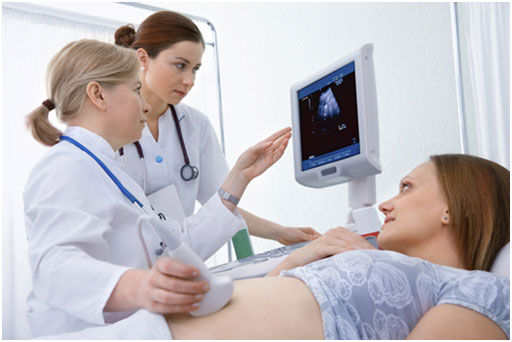
have all the information you possibly can before arriving at your ultrasound appointment? Of course you do! Your doctor should be willing (and able) to explain the entire procedure to you and give you the opportunity to ask any questions you may have. Depending on the organ that your physician intends to examine, you may have to prepare for the procedure in a specific way.
The majority of the time, fasting is necessary for six to eight hours before any abdominal ultrasound procedure. Air or gas can significantly block the sound waves so fasting reduces obstructions in the form of bowel gas that could interfere with the imaging of the abdominal organs. Sometimes, your doctor will ask you to eat a fat-free meal the night before your test (before you begin your fast). It’s important to inform your doctor of any concerns you have.
It’s also important to note that even if you can’t eat anything, staying hydrated and continuing to take any medications you need is essential, unless your doctor has instructed you otherwise.
Besides that, we recommend that you feel as comfortable as you like the day of the exam. It never hurts to wear loose-fitting clothing. Although some doctor’s offices may ask you to wear a gown, most don’t require it.
Again, your GP should make any specific requests as to the preparation for your ultrasound pretty clear before the appointment. If you feel unsure about the procedure, call your doctor’s office to get clarification on how you can be ultimately prepared for your appointment or you can also call the ultrasound clinic where the ultrasound is being performed for more information.
We understand that it’s always nice to know what to expect when you arrive for your ultrasound. So, let’s play it out.
You’ll walk into the examination room and likely see the ultrasound machine – it looks like a super complicated computer. A small wand-like tool (almost like a microphone) called the transducer will be attached to it by a cord. The machine will send sound waves through the face of the transducer into your body. The transducer will receive the echoes (which bounce back from the organs by way of the computer generated images) that reflect from the organ being assessed. These images will be shown on the monitor in real time. It’s actually pretty amazing to see. Still images and video clips are taken and are stored for the radiologist to evaluate.
Once you get into this room, you may be asked to change into a hospital gown. You will lie down on the table on your back with your upper abdomen exposed.
The sonographer will come in and explain the procedure if you aren’t already familiar with it. A special lubricating jelly will be spread on the area that will be examined – your abdomen. This jelly eliminates any friction that may occur ensuring that the sound waves are emitted without disruption. The transducer will be moved over your abdomen sometimes with firm pressure sending the sound waves through your body. Interestingly enough, these waves are emitted at far too high a frequency for humans to hear and the sound waves cannot be felt. Once the echoes are reflected back into the ultrasound machine, the images will begin to appear on the computer monitor. If additional images are needed, the sonographer may ask you to shift around to get the best angle for the ultrasound, sometimes lying on your left side or your right side or even standing to obtain the necessary images.
Does it hurt? Not at all. The only thing you may experience will be slight discomfort from lying still in a certain position for an extended period of time. You will be asked to hold your breath for short periods of time during the ultrasound also. Besides that, the gel may feel slightly cold and wet. Not exactly the best feeling, but it’s really not that bad at all.
To obtain crystal clear images for accurate ultrasound results, your procedure should only take at most 30 minutes. After that, the gel will be cleaned off of your belly, and you are free to go about your day! It’s as simple (and noninvasive) as that!
Do you want the good news or the great news?
The great news is that there aren’t any risks involved with abdominal ultrasounds (another big Whew)! Unlike many other medical tests, ultrasounds do not employ radiation, so there is absolutely no danger involved in this procedure.
Now…onto the good news! Ultrasounds are painless – but they may be a tad uncomfortable if you are experiencing any pain or sensitivity in your abdomen. If you ever do feel pain, let the sonographer know right away.
Ultrasounds are noninvasive, which means the process is conducted on the surface of the abdomen without the involvement of any messy or nerve-wracking tools. Another good point to raise is that it is extremely easy to schedule an appointment for an abdominal ultrasound.
Abdominal ultrasounds are also incredibly accurate. In a matter of seconds, a clear image is displayed on the screen – how futuristic is that? In most cases, the sonographer or sonologist can view the image on the screen and have a pretty good idea of what’s happening in there. Sometimes they will tell you right then and there and other times you have to wait to have your GP explain it especially if you have to have further testing to clarify findings.
Surprisingly, ultrasounds are also fairly low in cost when compared with other medical procedures. So it won’t cost you an arm or a leg to find out where your pain or discomfort is originating from.
Lastly, abdominal ultrasounds provide a dynamic assessment – meaning that you have the opportunity to interact with the sonographer and learn about things while you go. It’s not an impersonal sort of test where you have to be absolutely still and quiet. Feel free to ask any questions that arise during the test, and the sonographer will be happy to answer them in every way possible.
You’ve done it! Now, the hard part is over! Often you will have a pretty good idea when you leave the ultrasound room what is going on but unfortunately, sometimes you may have to wait to receive results from your GP.
After you have had an ultrasound, the images will be interpreted and reported by a consultant radiologist. A radiologist is a doctor that has been specially trained to interpret radiology examinations – thus, your ultrasound. After they interpret the images, they will send a signed report to your physician. Sometimes, if the radiologist is in-house, there is a chance they may discuss the results with you immediately after you have the ultrasound performed.
The radiologists may be asked to review the information more than once (or more than one radiologist may be consulted). The radiologists may request additional images of your abdomen. If the radiologist finds an abnormality in your ultrasound, additional imaging in a different modality, or a further specialized type of ultrasound may be needed, depending upon the abnormality seen.
Your doctor should schedule a follow-up appointment with you to discuss the results of your abdominal ultrasound if the radiologist is not available at the time of the procedure. If the ultrasound results show any cause for concern, your doctor will discuss the necessary steps and treatment plans that are required with you.
The good news is that there are little to no restrictions after your ultrasound. Typically, you are free to return to your normal eating habits, and resume your everyday normal activities. Your doctor should inform you if there is anything specific you need to do or get done following your ultrasound.
Overall, there is nothing to be worried about when it comes to having an abdominal ultrasound. Remember, feel free to ask your sonographer any questions you may have because they are there to help you. Abdominal ultrasounds are truly an easy, noninvasive, effective way to get answers…and fast! So, now that you have ample information about abdominal ultrasounds, there’s no need to be nervous – simply lay back, relax, and let the professionals get a good look at what’s going on…inside your tummy!
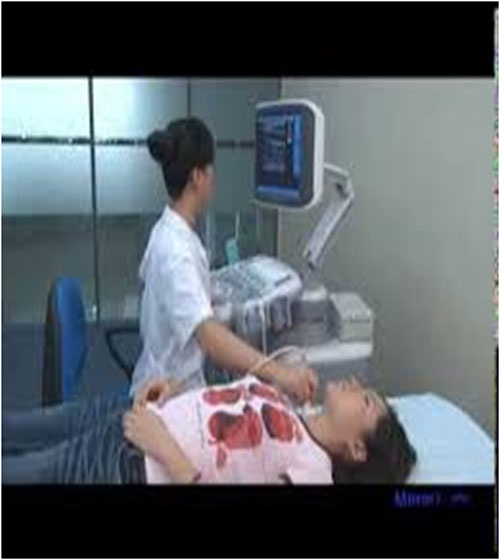
A Doppler ultrasound is a noninvasive test that can be used to estimate the blood flow through your blood vessels by bouncing high-frequency sound waves (ultrasound) off circulating red blood cells. A regular ultrasound uses sound waves to produce images, but can't show blood flow.
A Doppler ultrasound may help diagnose many conditions, including:
A Doppler ultrasound can estimate how fast blood flows by measuring the rate of change in its pitch (frequency). During a Doppler ultrasound, a technician trained in ultrasound imaging (sonographer) presses a small hand-held device (transducer), about the size of a bar of soap, against your skin over the area of your body being examined, moving from one area to another as necessary.
This test may be done as an alternative to more-invasive procedures, such as angiography, which involves injecting dye into the blood vessels so that they show up clearly on X-ray images.
A Doppler ultrasound test may also help your doctor check for injuries to your arteries or to monitor certain treatments to your veins and arteries.
Advantages of color Doppler imaging for the evaluation of vertebral arteries.
Assessment of the vertebral arteries is often difficult with conventional duplex ultrasonography. This study of 60 patients aimed to determine the potential advantages of color Doppler imaging over conventional duplex ultrasonography in the evaluation of vertebral arteries, specifically three extracranial segments of these vessels. Both methods allowed visualization of the vertebral artery in the midcervical course (V2 and distal V1 segments) in all subjects. Color Doppler imaging appeared more effective for visualization of the V0 and the proximal V1 segments (on the right side in 88% of patients and on the left side in 73%). Conventional duplex ultrasonography imaged the ostium on the right side in 80% of patients and on the left side in 65%, but was difficult and time-consuming. Visualization at the atlas loop (V3 segment) was rarely successful with duplex sonography, whereas color Doppler imaging visualized the vertebral artery on the right side in 87% of patients and on the left side in 85%. Color Doppler imaging allows better visualization of the proximal and distal segments of the vertebral arteries, compared to conventional duplex ultrasonography.
70% OF MEDICAL DECISIONS RELY ON PATHOLOGY
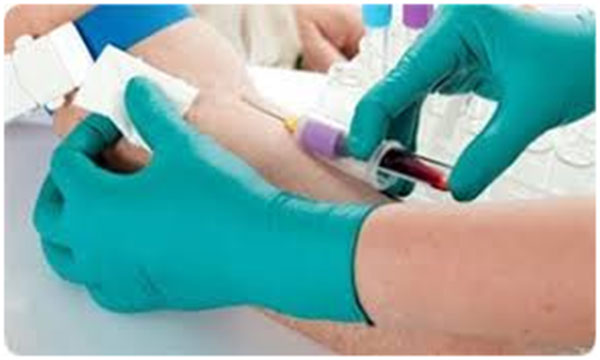
Pathology is a medical specialty that determines the cause and nature of diseases by examining and testing body tissues (from biopsies and pap smears, for example) and bodily fluids (from samples including blood and urine). The results from these pathology tests help doctors diagnose and treat patients correctly.
Every Australian receives their first pathology test just days after they are born. It is a blood test that screens for serious genetic conditions. From then on we rely on blood tests, biopsies and a multitude of other pathology tests to prevent, diagnose and treat infections, allergies, chronic diseases, cancers and countless other medical conditions. Read more about the most
The Digital Imaging and Communications in Medicine (DICOM) standard was created by the National Electrical Manufacturers Association (NEMA) to aid the distribution and viewing of medical images, such as CT scans, MRIs, and ultrasound. Part 10 of the standard describes a file format for the distribution of images.
Sometimes it is useful to be able to view and manipulate medical images such as X-rays, CT or MRI scans on your own PC, laptop or tablet. This is particularly important when preparing teaching files or practising for your radiology exams. Finding a good free DICOM viewer can be tricky, especially as there are so many options out there. We have tested may different applications (so you don't have to) and the following are our best picks. We grouped them according to the operating system used because
DICOM stands for 'Digital Imaging and Communications in Medicine'. It is the standard for handling, storing, printing, and transmitting information in medical imaging. DICOM viewing software allows radiology trainees and consultants to view and manipulate medical images (such as radiographs or MRI scans) on their own PC, laptop or tablet. In the hospital environment, this forms part of the picture archiving and communication system (PACS), which doctors will be familiar with!
A popular software for radiologists working in the UK is currently a programme called 'Horos'. This is a free open source version of the software used by the Royal College of Radiologists for the viva part of the Final FRCR 2B exam, so obviously it makes sense to use it for teaching as well. This programme is only available on Apple computers, hence why so many radiologists own MacBooks.
There is a paid version of Horos called 'OsiriX MD', which is produced by Pixmeo, however it costs £736 so it's not ideal for basic teaching purposes, although has good functionality. "Whoa, Hold on!", I hear you say. I thought this page was about free DICOM viewing software! Where did the £736 OsiriX MD come from?! Well I mention it as there is also a free version called 'OsiriX Lite'. It's a demo version of OsiriX MD, which the majority of radiologists used to use, however recently there have been major limitations placed on this free version to encourage users to pay for the full version. These limitations include adding 'NOT FOR MEDICAL USE' in red letters to every image, constant pop-ups asking you to upgrade to OsiriX MD, performance restrictions (OsiriX Lite is only 32-bit, not 64-bit) and image viewing restrictions. More frustratingly, in OsiriX Lite you cannot edit some of the meta-data attached to DICOM images - for example it is now difficult to re-order series within a study, which may be important if you are preparing teaching cases or examinations.
It is for these reasons, and more, that we have decided to give our recommendations to help you decide which programme is best for you!
Main features
OS: MacOS X 10.8 or higher
Horos should run on any Mac brought within the last 3 years.
We really like Horos as it is a free open source version of the same software as that used by The Royal College of Radiologists for the viva part of the final FRCR (Part B) exam. Becoming familiar with Horos will help radiology trainees when preparing for this exam. Horos is easy to use and there is a huge amount of functionality contained within. It is based upon OsiriX, however it doesn't have the software restrictions that 'Osirix Lite' has meaning that it is a fully functional 64-bit medical image viewer for MacOS X. It was released in 2015 and is updated regularly. We believe Horos is the best free DICOM viewer for Apple MacOS.
Interestingly, Horos is named after the Egyptian god Horus, son of Osiris and Isis. Horos is a based on OsiriX, named after Osiris. The developers obviously appreciate Egyptian and greek mythology!
Visit the Horos website to download the Horos DICOM viewer!
Radiopaedia plugin for Horos
OsiriX Lite DICOM Viewer
Main featuresOS: MacOS X 10.8 or higher
OsiriX Lite should run on any Mac brought within the last 3 years.
We like Osirix Lite as it is a free version of the same software used by The Royal College of Radiologists for the viva part of the final FRCR (Part B) exam. Osirix is easy to use and there is good basic functionality contained within as a result of years of research and development. The main disadvantages of OsiriX Lite over Horos is that the software has been dumbed-down and is only a demo (unless you fork out £736 for the full version of OsiriX MD). OsiriX Lite is only 32-bit (not 64-bit) meaning that it doesnt take full advantage of modern computing power. There is a 4GB upload limit and it will not display series of 500+ images. More frustratingly every image has "NOT FOR MEDICAL USAGE" displayed and you are constantly nagged with adverts to upgrade to OsiriX MD. Even so, we believe OsiriX Lite is a good free DICOM viewer for Apple MacOS and you will not be disappointed.
Main features
We really like RadiAnt as it is free, simple, easy to use and very fast. Watch this YouTube demonstration video to see RadiAnt in action. It is downloaded as a single compact application with an installer size of just over 2MB. The application can even run directly from a USB stick! This basic DICOM viever does all the things you would expect and is perfect for revision purposes for radiology trainees.
Main features
System requirements
Reports
Global Consultants
Global Customers
Reports Within Four Hours*
Success Story*
Available All Facility*
29, Shanti Nagar, Above Canara Bank,, Shri Nagar Extension, Khajrana Road, Indore, Madhya Pradesh 452001
Phone:- 0731-4970807, 9285270808, 9752970807
Email: thebiopsy2016@gmail.com
Follow us
